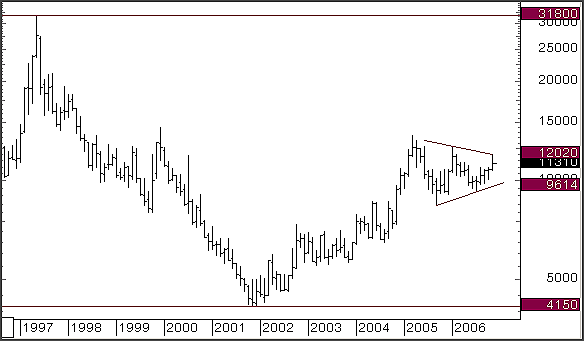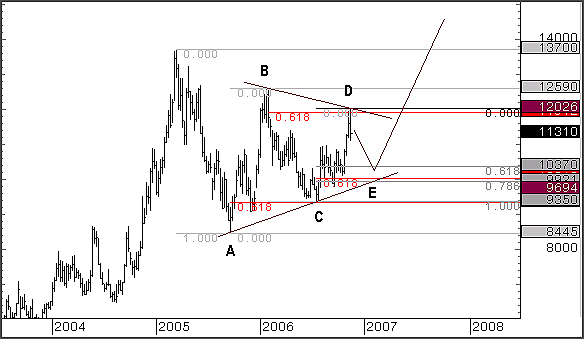
HOT TOPICS LIST
- MACD
- Fibonacci
- RSI
- Gann
- ADXR
- Stochastics
- Volume
- Triangles
- Futures
- Cycles
- Volatility
- ZIGZAG
- MESA
- Retracement
- Aroon
INDICATORS LIST
LIST OF TOPICS
PRINT THIS ARTICLE
by Dominick Mazza
First it was gold, then oil, most recently the grains. Will coffee be next to surge?
Position: N/A
Dominick Mazza
Analyst and founder of www.tradingthecharts.com. The website specializes in technical approaches to commodities markets using Elliott wave, Fibonacci, cycles and proprietary indicators.
PRINT THIS ARTICLE
TECHNICAL ANALYSIS
Coffee Break?
11/22/06 08:35:45 AMby Dominick Mazza
First it was gold, then oil, most recently the grains. Will coffee be next to surge?
Position: N/A
| From 1997 through the end of 2001, coffee was stuck in the harshest of bear markets. As you can see in the monthly continuation chart (Figure 1), that four-year period saw the price drop from a high of 31800 all the way down to 4150, more than an 85% decline! Since then, coffee has moved in an uptrend and now, after peaking in March 2005, it is consolidating in a pattern that may trace out a contracting triangle. |

|
| FIGURE 1: COFFEE, MONTHLY. The four-year period between 1997 and 2001 saw the price of coffee plummet a more than 85% decline. |
| Graphic provided by: MetaStock. |
| |
| A close-up of the pattern forming in the weekly chart (Figure 2) shows coffee trading precisely at Fibonacci measurements while strictly following Elliott wave rules. Both waves C and D were a perfect 0.618 of the preceding wave in the same direction. Wave C was 0.618 of wave A and wave D was 0.618 of wave B. These concurrences are strong indications that the triangle is indeed the operative pattern and forecast a strong breakout to the upside. They also give a vigilant trader excellent entry and exit points. |

|
| FIGURE 2, COFFEE, WEEKLY. Note that coffee is trading precisely at Fibonacci measurements while strictly following Elliott wave rules. |
| Graphic provided by: MetaStock. |
| |
| Of course, as perfect as the situation appears, even markets that follow patterns very closely can disappoint and leave traders hanging. This pattern is in a late stage, where a breakout or "thrust" out of the triangle should be expected once the E wave low is in. How do you set up your trade to maximize profit and minimize risk at the same time? The answer, of course, can be found in the same Elliott wave rules and Fibonacci analysis that confirmed the triangle for us in the first place. |
| The critical wave labeled E on Figure 2 has one very important rule. For the triangle analysis to remain intact as shown, coffee cannot trade below the C wave. What's needed is an orderly descent into the 9900–10400 area, and then a strong rally from that low. As coffee pulls back, buy as close to the C wave as possible, making that C level your stop. Reaching or breaking the trendline that connects the A and C waves is also a common practice. If coffee turns and trades up through the triangle, you're positioned for maximum profit. If it breaks below the C wave, you're stopped out of your position before being exposed to significant loss. An alternate pattern would have prices rally here above the D wave high instead of moving lower, only to sell off closer to 8400 before ending its correction. So in this case, trading lower first is bullish. |
| Is coffee about to enjoy a bull run? I'm not going to guess. But using this strategy gives me a favorable risk/reward on the trade with appropriate targets and a stop. |
Analyst and founder of www.tradingthecharts.com. The website specializes in technical approaches to commodities markets using Elliott wave, Fibonacci, cycles and proprietary indicators.
| Website: | www.tradingthecharts.com |
Click here for more information about our publications!
PRINT THIS ARTICLE

|

Request Information From Our Sponsors
- StockCharts.com, Inc.
- Candle Patterns
- Candlestick Charting Explained
- Intermarket Technical Analysis
- John Murphy on Chart Analysis
- John Murphy's Chart Pattern Recognition
- John Murphy's Market Message
- MurphyExplainsMarketAnalysis-Intermarket Analysis
- MurphyExplainsMarketAnalysis-Visual Analysis
- StockCharts.com
- Technical Analysis of the Financial Markets
- The Visual Investor
- VectorVest, Inc.
- Executive Premier Workshop
- One-Day Options Course
- OptionsPro
- Retirement Income Workshop
- Sure-Fire Trading Systems (VectorVest, Inc.)
- Trading as a Business Workshop
- VectorVest 7 EOD
- VectorVest 7 RealTime/IntraDay
- VectorVest AutoTester
- VectorVest Educational Services
- VectorVest OnLine
- VectorVest Options Analyzer
- VectorVest ProGraphics v6.0
- VectorVest ProTrader 7
- VectorVest RealTime Derby Tool
- VectorVest Simulator
- VectorVest Variator
- VectorVest Watchdog
